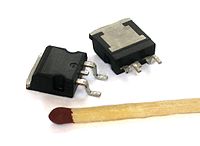
Photo from wikipedia
Vertical-cavity surface-emitting lasers (VCSELs) have been widely used in short-reach optical communication links and interconnects because of their high modulation speed and low energy consumption. In this paper, the effect… Click to show full abstract
Vertical-cavity surface-emitting lasers (VCSELs) have been widely used in short-reach optical communication links and interconnects because of their high modulation speed and low energy consumption. In this paper, the effect of heat dissipation on the modulation bandwidth of high-speed 850-nm VCSELs has been investigated. With increasing bottom distributed Bragg reflector (DBR) diameter from 34 μm to 46 μm, optical output power increased as well as the −3 dB modulation bandwidth. The maximum small-signal modulation bandwidth of 16.2 GHz was achieved with an aperture of 5 μm. Thermal analysis showed that the heat dissipation of the bottom DBR diameter, which determined the differential gain of the quantum wells, has a strong effect on the modulation bandwidth.
Journal Title: Journal of Applied Physics
Year Published: 2017
Link to full text (if available)
Share on Social Media: Sign Up to like & get
recommendations!